It has appeared on stamps and been featured in an Olympic ceremony, inspired works of fine art and comedic spoofs. This seemingly simple invention, the Hills Rotary Hoist (or simply “Hills Hoist”), is a fixture of the classic Australian Dream: a house on a quarter-acre lot with a big backyard, incomplete without a particular type of rotating clothesline.
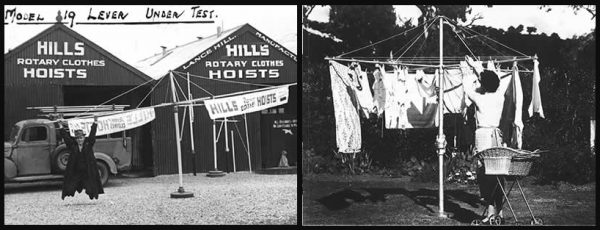
The Hills Hoist was developed in Adelaide, South Australia by World War II veteran Lance Hill in 1945. As the story goes: Hill got home from the war and realized his backyard was getting crowded, so he designed and built a rotary clothesline from some old pipe.
The line could also be hoisted up to catch breezes after being loaded with wet laundry. It wasn’t the first of its kind, but it became a household name, well-timed to take off in an era of post-war growth.
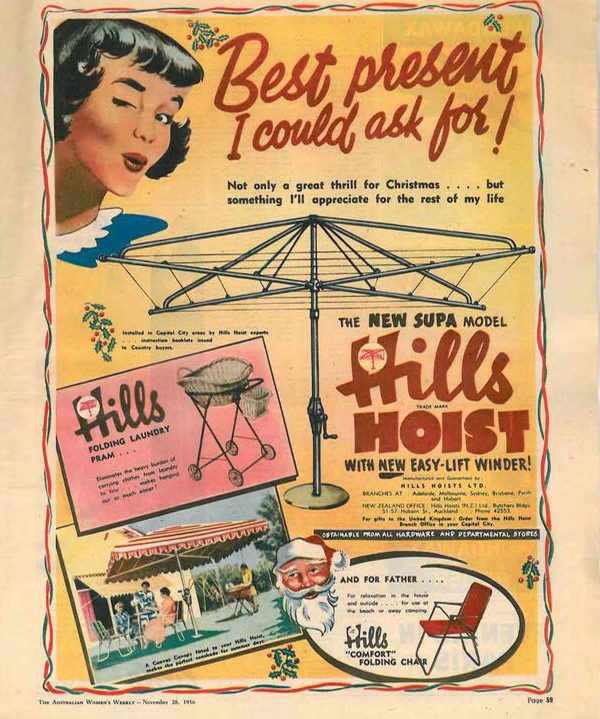
After overhearing some neighbors talking about his device, Hill decided to go into business building and selling clotheslines. His first batch was made from tubing salvaged from under the Sydney Harbor Bridge, originally hung to catch enemy subs in WWII. Today, over 5 million Hills Hoists are sold per year worldwide. Modern models have extra features, too, able to be folded down and lifted out of the ground.
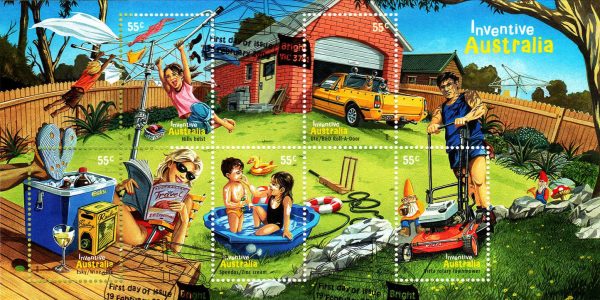
The device went on to become an icon of the country over the decades and is listed as a National Treasure by the National Library of Australia. The National Museum of Australia also had a Hills Hoist on display for a time. But it is more than just a point of pride or everyday design object — the Hills Hoist has shaped the culture and activities of a nation.
Much More Along Those Lines
As dominant fixtures of Australian backyards, these pervasive clotheslines have evolved uses well beyond their designer’s intent. Kids, for instance, hang from and spin around on their sturdy rotating beams (with or without water slides augmenting the experience).
Adults decorate Hills Hoists with anything from ornaments for birthday parties to fancy chandeliers for romantic backyard weddings. Hoist frameworks can also be used for DIY sheet-and-blanket forts.
An entire drinking game has evolved around Hills Hoists: Goon of Fortune (inspired by Wheel of Fortune) involves hanging “goon sacks” (bags of cheap wine) on the lines. The edge is spun and people standing around it drink when a bag comes to a stop in front of them.
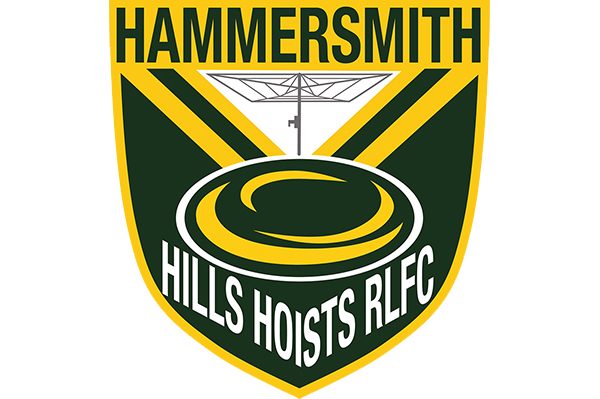
The icon’s reach also extends beyond Australia. In England, an expat-founded rugby team took more than just its name from the Hills Hoist. The Hammersmith Hills Hoists (RFLC) went so far as to add an abstracted image of the rotary clothesline to their official emblem.
At Home & Online
Australian Hills Hoist owner (and 99% Invisible fan) Alisa Stephens grew up surrounded by these contraptions. Her grandparents maintained a carefully cultivated vegetable garden and manicured lawn in their quarter-acre lot’s yard, yet “smack bang in the middle of the lawn, with a concrete path leading up to it, was their rotary clothesline.” Hills Hoists were also visible in neighboring yards on all sides.

“As a kid,” she recalls, “my dad would lift me up and let me hold onto an arm and would walk me around, spinning the clothesline as he held me around the waist. [It] kind of felt like flying.” She also played a doughnut-eating game at birthdays with pastries hanging on the lines: “hold your hands behind your back and eat as fast as you can. Whoever finishes first wins (although, with donuts, everyone wins, right?).”
Stephens recently decorated her family’s Hoist for a birthday party, but also finds it useful for its original purpose: hanging laundry. It is easy to reach up and spin the lines around to find an empty space, then extend them vertically as needed to hang longer things (like sheets).

Her backyard Hoist is a newer and improved version. “The 1960s model of my childhood was dug up when we extended the house in 1997,” she explains, “and a modern one was put in.” Technically it is removable (the pole lifts out of the ground) but realistically it tends to stay put, in part because the sides can be folded down as needed.

Recently, though, Stephens has observed a lot of newer estates cropping up “full of McMansions where everyone needs a bedroom, a rumpus room and an en suite off the master, with a big deck out back,” all of which leaves less room for a full-sized Hills Hoist. As a result, “rotary clotheslines aren’t as common in new developments.” Instead, “you’re more likely to find a folding-frame clothesline, mounted either to the back or side of a house or to the fence.”
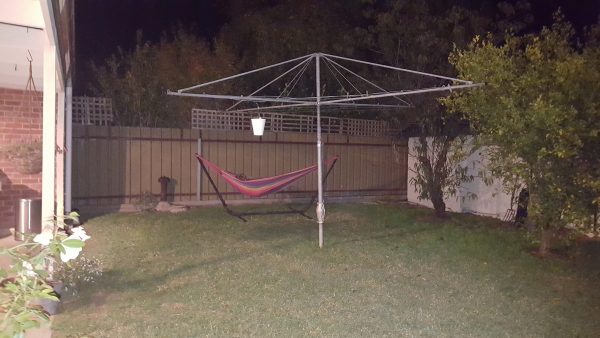
Still, Stephens (like many others) remains a fan. “As much as I don’t actually enjoy doing the laundry,” she says, “I really do love the Hills Hoist. They look iconic, and when they’re full of sheets and flapping in the breeze they can be really calming! I even love the creaky noise they make as they shift around — it’s a sound of summer for me.”



Comments (14)
Share
We had 11 children in my family and washing day was big. We had a Hills Hoist and a two wire clothes line extending across our back yard. Laundry was done in a huge barrel washing machine with an electric wringing on the top. Dad would feed the clothes into the wringer, Mum would catch them, often having to repeat the process, then drop the laundry into a big cane basket that the two of them would then carry to the clothes line to hang out to dry.
When the line was free from clothes, we did use it as a toy, sometimes getting as many as three spins before Mum would yell at us from the kitchen window.
Growing up in suburban Sydney we jokingly referred to our hills hoist as going on holidays when during the warmer longer days of summer my dad moved it round to the side if the house, read out of site.
This meant we had free reign over a vast swathe of buffalo grass to play on. But when the line had to be moved back for winter there was the hilarious sight of my dad on hands and knees in the yard looking for the elusive hole for it.
Many memories
Julian, of the hydraulic Hills Hoist: I’ve seen these in suburban Hobart. Turning on the tap would raise the clothesline, and turn off the tap it would lower back down again. I guess how far up it would go would depend on the mains pressure where you lived.
As an Australian I have to love this article- thanks 99PI! While many Australian houses now have a dryer, it’s not something we use very often at all, preferring the more economical clothesline option. Plus, laundry smells so much better when it’s been air dried. When I visited my in laws in the US some years ago and asked were I could hang clothes my father in law referred to me as a “barefoot hippy” and told me many new developments in the US don’t allow clotheslines as it ruins to the look of the neighbourhood. How odd!
Sadly, the majority of new housing developments in the US are “HOAs.” Home Owners Association. They horrible and consist of stupid rules within the development.
My grandmother had a backyard with a downhill slope – was so much fun hanging off the Hills Hoist as it swung out out over the steep parts! Me and my brother and cousins spent hours, days playing with that thing.
There’s a similar model in my back yard right now.
When my girlfriend’s family sold her departed grandparents’ property in suburban Melbourne, I had the opportunity to tour the place before auction. Her grandfather, a tinkerer in his retirement, had augmented the Hills Hoist with a hydraulic hoisting system that automatically raised the line. It was hydraulic in the purest sense – to activate it you’d literally turn on a water tap and water would come bubbling out of the central post as the whole thing went up. I wish I’d taken video of it in retrospect, one of the most ingenious things I’ve seen since, well, the Hills Hoist itself!
The Hills Hoist was also a source of some serious accidents. Let me recount a tale told by my mother…….
In the days before town sewerage, a lot of houses had an outside toilet which has a little trapdoor in the back. Sometime during the night the ‘nightman’ would come through the darkened back yard and change the used can for an empty one.
The normal practice was to carry the can in on the left shoulder and out on the right. This allowed the nightman would discover any shoulder height obstructions on the way in.
One windy night, with some washing still on the line, the line must have rotated a little. The nightman discovered this on the way out with the resulting stream of profanity waking the household. The morning light revealed the reason for the nightime noise, and I’m sure, if it could, the Hills Hoist would have had a goofy smile on its dial.
What’s odd is that I can remember in backyards in the 1960s… In Boston, Mass.
Didn’t realize these were Australian. I was born in SF bay area, I remember one of these in my grandparent’s back yard in the early 1990s in San Leandro.
Here is an article outlimimg Toyne as the inventor prior to Hills taking the patent and developing the product successfully….
https://www.news.com.au/lifestyle/real-life/true-stories/the-amazing-and-sad-true-story-behind-an-iconic-australian-invention/news-story/07bf859445a42070b543d1fcae379ee8
I’m playing through a videogame called “The Gardens Between” and at one point I noticed a Hills hoist in the background. I looked it up, and indeed the developers are from Australia!
That detail would’ve gone completely unnoticed if I hadn’t read this 99pi article. ;)
Lance Hill designed his hoist but he did NOT invent the hoist or the mechanism. This was done decades earlier by Gilbert Toyne.
Toyne was a true Australian patriot serving in both wars and as a consequence let his patent lapse.
Lance Hill was a better salesman than Toyne.
https://www.abc.net.au/news/2019-09-22/australian-design-hills-hoist-history-clothesline/11524676